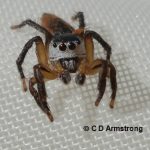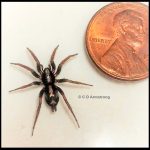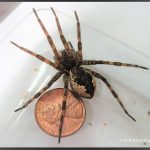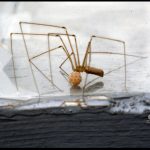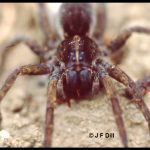Spiders
Pest Management Fact Sheet #5046
James F. Dill, Pest Management Specialist
Clay A. Kirby, Insect Diagnostician
Charles D. Armstrong, Cranberry Professional & Staff Entomologist
For information about UMaine Extension programs and resources, visit extension.umaine.edu.
Find more of our publications and books at extension.umaine.edu/publications/.
Description & Biology
Spiders have been the subject of negative publicity for years. Their secretive nature, way of moving, and predatory nature make them common villains in folklore and popular media. Fear of a few highly venomous spiders, such as the black widow and brown recluse, has expanded to include all spiders. Fortunately, black widows and brown recluse spiders are not native to Maine and are not known to survive our winter temperatures. Spiders can be considered to be beneficial when they feed on household and garden insect pests. It is unfortunate that many incidents of unknown skin irritation or sores are attributed to spider bites.
Spiders have two body regions (a fused head and thorax–called the cephalothorax–and an abdomen) as well as eight legs. Spiders are relatives of insects, the latter of which have three body regions (head, thorax and abdomen) and only six legs. Spiders spin silk which can be used to make webs for holding eggs, securing prey, or transportation. Some spiders wait for prey to get caught in their webs while others actively hunt for prey. Chance encounters with spiders or their webbing in unlikely places can render them a nuisance. Some spiders–size permitting–may bite in self-defense when carelessly handled or accidentally trapped in clothing.
Common types of spiders occasionally encountered indoors include wolf, parson, fishing, jumping and cellar spiders. Wolf and fishing spiders tend to be large, hairy and fast. They tend to wander into houses, garages, sheds, etc. from the outdoors, in search of warmth and shelter. Fishing spiders are most common along lakes, rivers and marshes and can feed on small fish and tadpoles. Some of them can walk on water! Others–Dolomedes tenebrosus, for example–are more terrestrial so are often found in dry woodlands. Parson spiders are free-roaming hunters that are black with a white distinctive pattern on the abdomen. Jumping spiders are smaller and more compact, often moving in short, quick starts. Cellar spiders have long spindly legs and are responsible for the abundant formation of cobwebs. They are usually stationary and remain closely associated with their webbing.
- Example of a species of Jumping Spider (Habronattus decorus) observed in Troy, Maine on 6/18/2008)
- Eastern Parson Spider, Herpyllus ecclesiasticus
- Fishing Spider (immature male)
- Dark Fishing Spider (Dolomedes tenebrosus) (Etna, ME; 3/21/2019)
- Female Cellar Spider (guarding her egg sac)
- Wolf Spider
Prevention
Spider problems can be avoided or lessened by sanitation and exclusion. Clearing out basement clutter (including wood piles) eliminates harborage. Moving outdoor wood piles away from the house also helps. Window and door screens should be intact and tight-fitting. Cracks and crevices in the foundation and siding should be sealed or caulked to prevent entrance of spiders.
Humidity should be lowered, if possible, in basements and crawl spaces. Using dimmer or yellow porch lights will cut down on the number of flying insects accumulating around outside lights, thus reducing the numbers of spiders attempting to capture them.
Control
Spiders and webs can be removed by frequent dusting, sweeping, or vacuuming in corners, under furniture, behind pictures and other hiding places. Any undisturbed area may harbor spiders. Since spiders eat insects, eliminating household insects will help cut down spider numbers indoors. As a last resort, household formulations of materials such as permethrin, bifenthrin, cyfluthrin, deltamethrin, tetramethrin, or pyrethrins sprayed in cracks and crevices and in corners (floor and ceiling) of rooms may be used to control both spiders and the insects they consume.
When Using Pesticides
ALWAYS FOLLOW LABEL DIRECTIONS!
Pest Management Unit
Cooperative Extension Diagnostic and Research Laboratory
17 Godfrey Drive, Orono, ME 04473
1.800.287.0279 (in Maine)
Information in this publication is provided purely for educational purposes. No responsibility is assumed for any problems associated with the use of products or services mentioned. No endorsement of products or companies is intended, nor is criticism of unnamed products or companies implied.
© 2016, 2020, 2023
Call 800.287.0274 (in Maine), or 207.581.3188, for information on publications and program offerings from University of Maine Cooperative Extension, or visit extension.umaine.edu.
In complying with the letter and spirit of applicable laws and pursuing its own goals of diversity, the University of Maine System does not discriminate on the grounds of race, color, religion, sex, sexual orientation, transgender status, gender, gender identity or expression, ethnicity, national origin, citizenship status, familial status, ancestry, age, disability physical or mental, genetic information, or veterans or military status in employment, education, and all other programs and activities. The University provides reasonable accommodations to qualified individuals with disabilities upon request. The following person has been designated to handle inquiries regarding non-discrimination policies: Director of Equal Opportunity, 101 Boudreau Hall, University of Maine, Orono, ME 04469-5754, 207.581.1226, TTY 711 (Maine Relay System).


